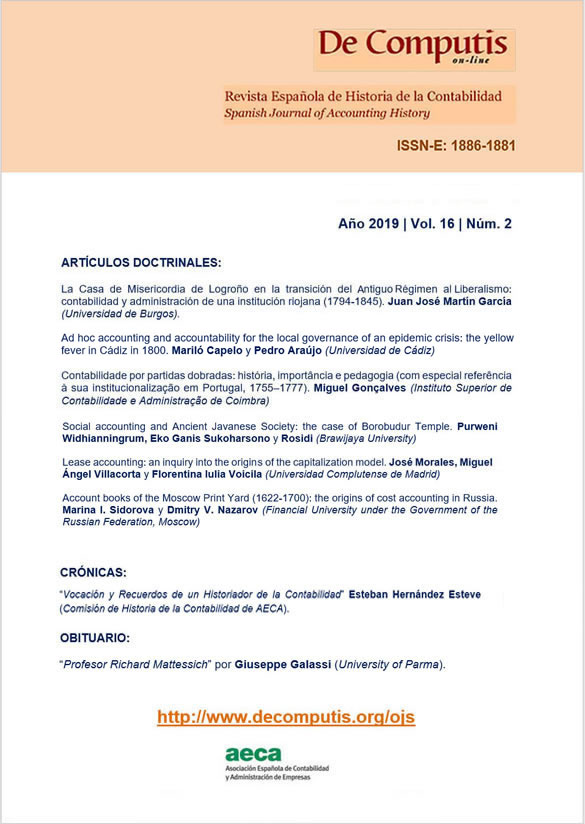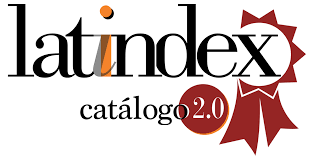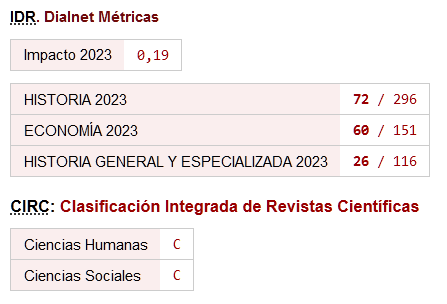Social accounting and ancient javanese society
the case of Borobudur Temple
DOI:
https://doi.org/10.26784/issn.1886-1881.v16i2.356Palabras clave:
social accounting, history, Borobudur, KarmavibhanggaResumen
The objective of this paper is to provide evidences of concerns about social accounting issues in ancient Javanese society in the case of Borobudur temple reliefs. This paper uses qualitative and interpretative approach as method. The data were collected through library research and observation in Borobudur temple. The result proves that social accounting in ancient Java was interpreted, as the manifestation of human’s spiritual journey to liberate himself from worldly desire in the quest for supreme enlightenment. The determination of sima and narrative reliefs about punishment for someone who captures and consumes natural resources excessively, provides evidences of good moral values contained in accounting and their implementation in business life. Based on the Buddhist philosophy, social accounting eventually came as an economic control and mediator for conflicts between human beings, their needs, and their environment in a holistic manner.
Descargas
Citas
Azul, S. U. (1989). The ancient carvings of Borobudur. In R. Badil, l. (1989), "",The Hidden Foot of Borobudur (pp. 131-152). Jakarta: Katalis.
Belkaoui, A. R. (1983). Economic, Political, and Civil Indicators and Reporting and Disclosure Adequacy: Empirical Investigation. Journal of Accounting and Public Policy , 2, 207-219. https://doi.org/10.1016/0278-4254(83)90025-X
Belkaoui, A. R., & Picur, R. D. (1991). Cultural Determinism and The Perception of Accounting Concepts. The International Journal of Accounting , 118-130.
Boyce, G., Prayukvong, W., & Puntasen, A. (2009). Social accounting for sufficiency: Buddhist principles and practices, and their application in Thailand. Public Interest Accounting , 14, 55-119. https://doi.org/10.1108/S1041-7060(2009)0000014007
Carmona, S., & Ezzamel, M. (2007). Accounting and Accountability in Ancient Civilizations: Mesopotamia and Ancient Egypt. Accounting, Audity and Accountability Journal , 20 (2), 177-209. https://doi.org/10.1108/09513570710740993
Choudhury, N. (1982). Aspects of Accounting and Internal Control-India 4th Century BC. Accounting and Business Research , 12 (46), 105-110. https://doi.org/10.1080/00014788.1982.9728795
Christie, J. W. (1998). Javanese Markets and the Asian Sea Trade Boom of the Tenth to Thirteenth Centuries A.D. Journal of the Economic and Social History of the Orient , 41 (3), 344-381. https://doi.org/10.1163/1568520981436264
Christie, J. W. (1992). Trade and value in pre‐Majapahit Java. Indonesia Circle , 21 (50&60), 3-17.
https://doi.org/10.1080/03062849208729789
Chua, W. F. (1986). Radical Developments in Accounting Thought. The Accounting Review , LXI (4), 601-632.
Costouros, G. J. (1977). Development of an accounting system in ancient Athens in response to socieo-economic changes. Accounting Historians Journal , 4 (1), 1-18. https://doi.org/10.2308/0148-4184.4.1.37
Dillard, J. (2009). Buddhist economics: A Path From an Amoral Accounting Toward a Moral One. Advances in Public Interest Accounting , 14, 25-53. https://doi.org/10.1108/S1041-7060(2009)0000014006
Dwijanto, D., Darmosoetopo, R., Nugrahani, D. S., & Yuwono, J. S. (1992). Pungutan Pajak dan pembatasan Usaha Di Jawa Pada Abad IX-XV Masehi. Universitas Gajah Mada, Fakultas Sastra. Yogyakarta: Fakultas Sastra Universitas Gajah Mada.
Fontein, J. (2010). The Path to Enlightenment. In N. Magetsari, J. Fontein, T. Haryono, I. B. Setiadi, & J. Ave (Ed.), Borobudur: Majestic Mysterious Magnificent (pp. 108-139). Yogyakarta, Indonesia: PT. Taman Wisata Candi Borobudur, Prambanan & Ratu Boko.
Francis, J. R. (1989). After Virtue? Accounting As A Moral And Discursive Practices. Accounting, Auditing, & Accountability Journal , 3 (3), 5-17.
https://doi.org/10.1108/09513579010142436
Gray, S. (1988). Towards a Theory of Cultural Influence on the Development of Accounting Systems Internationally. ABACUS , 24 (1), 1-15. https://doi.org/10.1111/j.1467-6281.1988.tb00200.x
Haryono, T. (2010). Javanese life in the ninth century. In J. Ave, Borobudur Majestic Mysterious Magnificient (pp. 141-187). Sleman, Yogyakarta, Indonesia: Taman Wisata Candi Borobudur, Prambanan & Ratu Boko.
Haryono, T. (1999). Sang Hyang Watu Teas dan Sang Hyang Kulumpang: Perlengkapan Ritual Upacara Penetapan Sima Pada Masa Kerajaan Mataram Kuna. Humaniora , 12, 14-21.
Haryono, T. (2013). Masyarakat jawa kuna dan lingkungannya pada masa Borobudur. In H. Santiko, 100 Tahun Pascapemugaran Candi Borobudur (pp. 55-66). Magelang, Indonesia: Balai Konservasi Borobudur.
Joesoef, D. (2015). Warisan Umat Manusia Borobudur. Jakarta, Indonesia: Kompas Media Nusantara.
Liyanarachchi, G. A. (2009). Accounting in ancient Sri Lanka: some evidence of the accounting and auditing practices of Buddhist monasteries during 815-1017 AD. Accounting History , 14 (1-2), 101-120. https://doi.org/10.1177/1032373208098554
Liyanarachchi. (2015). Antecedents of double-entry bookkeeping and Buddhist Temple Accounting. Accounting History , 20 (1), 85-106. https://doi.org/10.1177/1032373214560154
Magetsari, N. (2010). Buddhism in tenth century Java. In J. Ave, Borobudur Majestic Mysterious Magnificient (pp. 79-107). Sleman Yogyakarta, Indonesia: Taman Wisata Candi Borobudur, Prambanan & Ratu Boko.
Mattessich, R. (1989). Accounting And The Input-Output Principle In The Prehistoric And Ancient World. ABACUS , 25 (2), 74-84. https://doi.org/10.1111/j.1467-6281.1989.tb00222.x
Mattessich, R. (1998). Review and extension of Bhattacharyya's Modern Accounting Concepts in Kautilya's Arthasastra. Accounting, Business & Financial History , 8 (2), 191-209. https://doi.org/10.1080/095852098330512
Miksic, J. (2010). Borobudur in The Beginning. In J. Avé (Ed.), Borobudur Majestic Mysterious Magnificient (pp. 26-75). Yogyakarta, Indonesia: Taman Wisata Candi Borobudur, Prambanan & Ratu Boko.
Napier, C. J. (2001). Accounting History and Accounting Progress. Accounting History , 6 (2), 7-31. https://doi.org/10.1177/103237320100600202
Nigam, L. B. (1986). Bahi-Khata: The Pre-Pacioli Indian Double-Entry System Of Bookkeeping. ABACUS , 22 (2), 148-161. https://doi.org/10.1111/j.1467-6281.1986.tb00132.x
Payutto, P. (1994). Buddhist Economics A Middle Way for the Market Place. Bangkok, Thailand: Buddhadhamma Foundation.
Previts, G. J., Parker, L. D., & Coffman, E. N. (1990). An Accounting Historiography: Subject Matter and Methodology. ABACUS , 26 (2), 136-158. https://doi.org/10.1111/j.1467-6281.1990.tb00250.x
Rahardjo, S. (2011). Peradaban Jawa Dari Mataram Kuno sampai Majapahit Akhir. Jakarta: Komunitas Bambu.
Santiko, H. (1989). Karmawibhangga, the secret of ancient Java. In R. Badil, The Hidden Foot of Borobudur (pp. 13-38). Jakarta, Indonesia: Katalis.
Santiko. (2012). Relief Karmawibhangga di Candi Borobudur: Identifikasi Adegan dan Ajaran Hukum Karma. In I. Wahyuningsih, & R. WDP, Adegan dan Ajaran Hukum Karma pada Relief Karmawibhangga (pp. 1-14). Magelang, Yogyakarta, Indonesia: Balai Konservasi Borobudur.
Satrio A., J. (1989). The Buried Teaching Meant for Mankind. In R. Badil, & N. Rangkuti, The Hidden Foot of Borobudur (pp. 51-80). Jakarta: Katalis.
Soediman. (1973). Borobudur, Indonesian Cultural Heritage. Studies in Conservation , 18, 102-112. https://doi.org/10.1179/sic.1973.010
Soekmono. (1976). Chandi Borobudur: A Monument of Mankind. Netherlands: The Unesco Press.
Solas, C., & Ayhan, S. (2007). The Historical Evolution Of Accounting In China: The Effects Of Culture. Spanish Journal of Accounting History , 7, 146-173. https://doi.org/10.26784/issn.1886-1881.v4i7.175
Wahyuningsih, I., & Rini, W. D. (2012). 160 Panil Relief Karmawibhangga. In Adegan Dan Ajaran Hukum Karma Pada Relief Karmawibhangga (pp. 29-113). Magelang, Indonesia: Balai Konservasi Borobudur.
wikipedia. (2019, October 19). Retrieved November 1, 2019, from wikipedia: https://en.wikipedia.org/wiki/Bodhisattva
Yamey, B. S. (1994). Benedetto Cotrugli on Bookkeeping (1458). Accounting, Business & Financial History , 4 (1), 43-50. https://doi.org/10.1080/09585209400000035
Descargas
Publicado
Cómo citar
Número
Sección
Licencia

Esta obra está bajo una licencia internacional Creative Commons Atribución-NoComercial-CompartirIgual 4.0.










